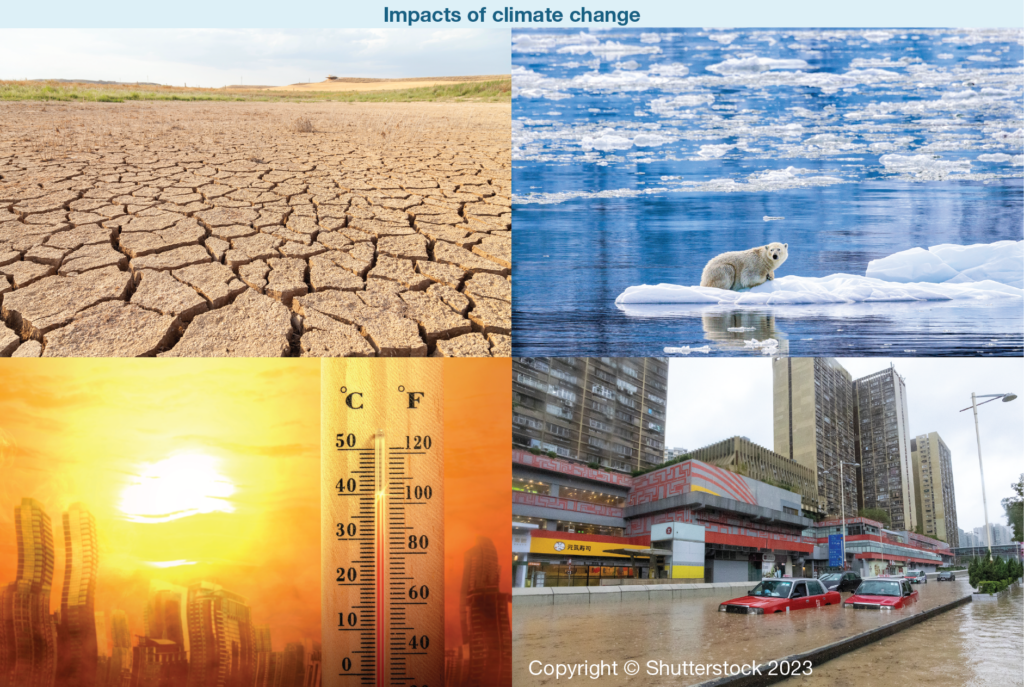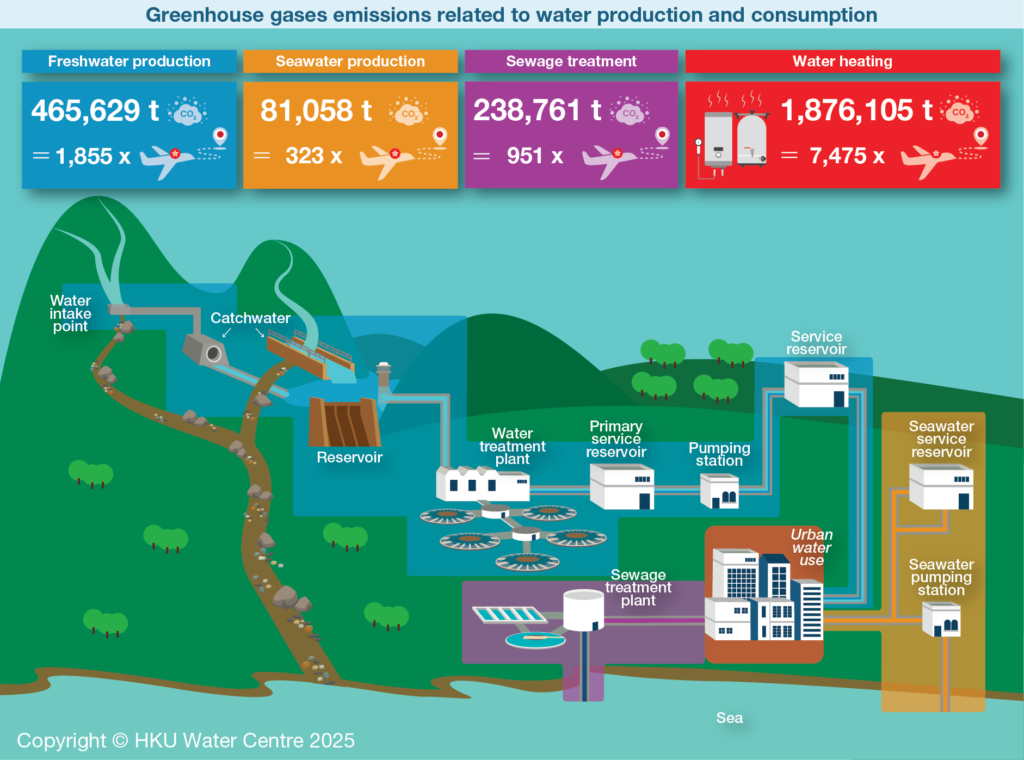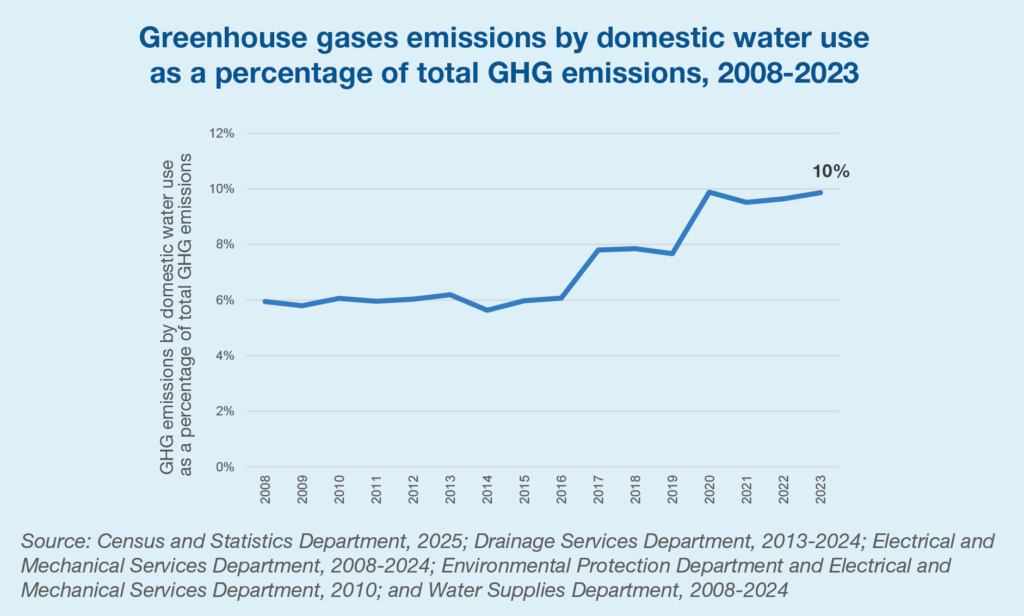
Index
How to cite
Lee, Frederick and Lee, Angela (2024) ‘Climate Change”, in Lee, Frederick. (ed) Water Resources Information Portal. Hong Kong: Centre for Water Technology and Policy, The University of Hong Kong.

1. Water-energy-climate nexus
Introduction
The importance of sustainable management of water resources in advancing the climate agenda was officially recognized and included in the agenda of the United Nations Climate Change Conference in 2022 (COP27). This acknowledgment highlights the linkages between water use, energy, and carbon emissions.
Greenhouse gases emissions
1.1 What are greenhouse gases?
1.2 What are the main sources of greenhouse gases emissions?
Some major contributors to greenhouse gases emissions include:
i.Burning of fossil fuels, such as coal, oil and natural gas for energy.
ii.Industrial processes, such as the production of steel and aluminium.
iii. Agriculture practices, including livestock farming and commercial cultivation.
Deforestation also reduces the planet’s capacity to naturally remove CO₂ from the atmosphere, thus resulting in an increase in the concentration of CO₂.
1.3 What is the “greenhouse effect”?
The greenhouse effect is a natural process where greenhouse gases in the Earth’s atmosphere trap the heat emitted by the sun, thus keeping the planet warm and habitable.
However, human activities, particularly the burning of fossil fuels, have led to the release of substantial amount of greenhouse gases, which has exacerbated the greenhouse effect and led to climate change.
1.4 What is climate change?
Climate change refers to the long-term alterations of global or regional climate patterns. Its manifestations include rising earth surface temperatures, changing precipitation patterns, sea-level rise and an increased frequency of extreme weather events.
1.5 What are the impacts of climate change?
- Changes in precipitation patterns, leading to droughts in some regions and increased precipitation in others.
- Changes in weather conditions, which affect plant and animal species, migration patterns and overall biodiversity.
- Increased frequency and intensity of extreme weather events.
- Shrinking icesheets and rising sea-levels, which pose threats to coastal areas and low-lying islands.
1.6 What ways is water associated with climate change?
Electricity is used to fuel the various aspects of tap water production, including water treatment, distribution, pumping, and sewage treatment.
However, an increased consumption of electricity, which is often generated by the burning of fossil fuels, would intensify the greenhouse effect.
At the same time, climate change would disrupt the normal processes of the natural water cycle, which then leads to adverse impacts on freshwater ecosystem health.
These interconnectednesses underscore the imperative for us to embrace sustainable water resources management practices so that we can mitigate the adverse impacts of climate change on the water cycle.
Water use and energy consumption
1.7 Does water use produce greenhouse gases?
Water use by itself does not directly produce greenhouse gases. However, the processes associated with tap water production and consumption—such as water treatment, distribution, pumping, and sewage treatment—often require electricity.
The generation of electricity, especially if it is derived from burning fossil fuels, would produce greenhouse gases emissions.
Therefore, while water use per se is not a direct emitter of greenhouse gases, it is crucial for us to consider the energy implications of using water.
1.8 How much greenhouse gases emissions are associated with tap-water production in Hong Kong?
Tap-water production refers to the process of turning raw water into potable water. In 2022/23, greenhouse gases emissions associated with tap-water production was equivalent to 0.437 kg CO₂/m³.
Considering that total freshwater consumption in Hong Kong in 2022/23 reached 1,066,000,000 m³, the amount of greenhouse gases emissions associated with water use was estimated to hit 465,842 tonnes of CO₂ equivalent (CO₂ e).
1.9 How much greenhouse gases emissions are associated with water production and consumption in Hong Kong?
Water production and consumption have indirectly generated greenhouse gases emissions in three ways: Potable water production, seawater production, and sewage treatment.
Potable water production:
In 2022/23, 465,629 tonnes of CO₂ e of greenhouse gases emissions were generated. This amount is equivalent to the emissions produced by 1,855 return flights from Hong Kong to Tokyo.
Seawater production:
In 2022/23, 81,058 tonnes of CO₂ e of greenhouse gases emissions were recorded. This figure is equivalent to the emissions produced by 323 return flights from Hong Kong to Tokyo.
Sewage treatment:
In 2022/23, 238,761 tonnes of CO₂ e of greenhouse gases emissions were registered. This amount is , equivalent to the emissions produced by 951 return flights from Hong Kong to Tokyo.
1.10 How much greenhouse gases emissions are generated by domestic water heating?
In 2022/23, domestic water heating generated 1,876,105 tonnes of CO₂ e of greenhouse gases emissions. This figure is equivalent to the emissions produced by 7,475 roundtrip flights from Hong Kong to Tokyo.





